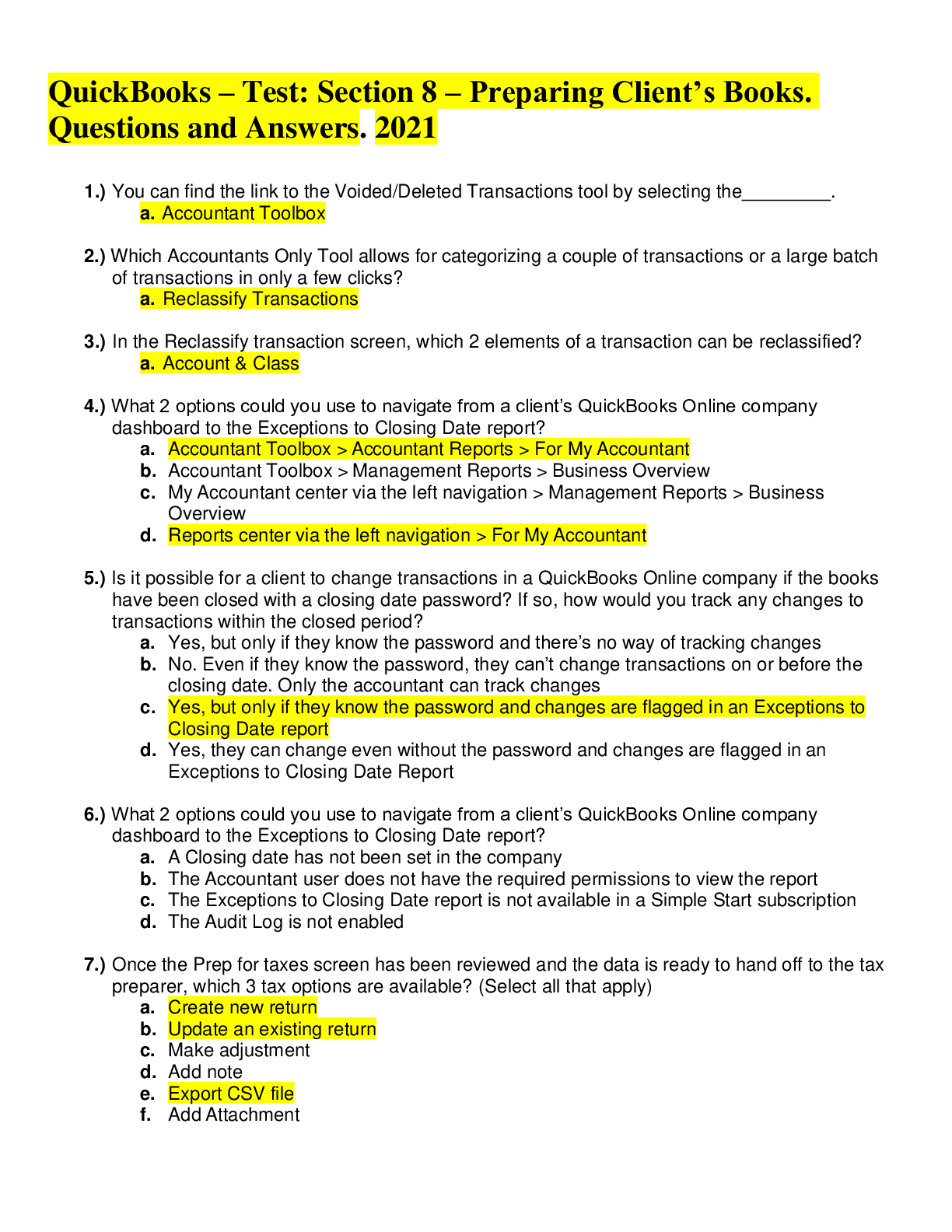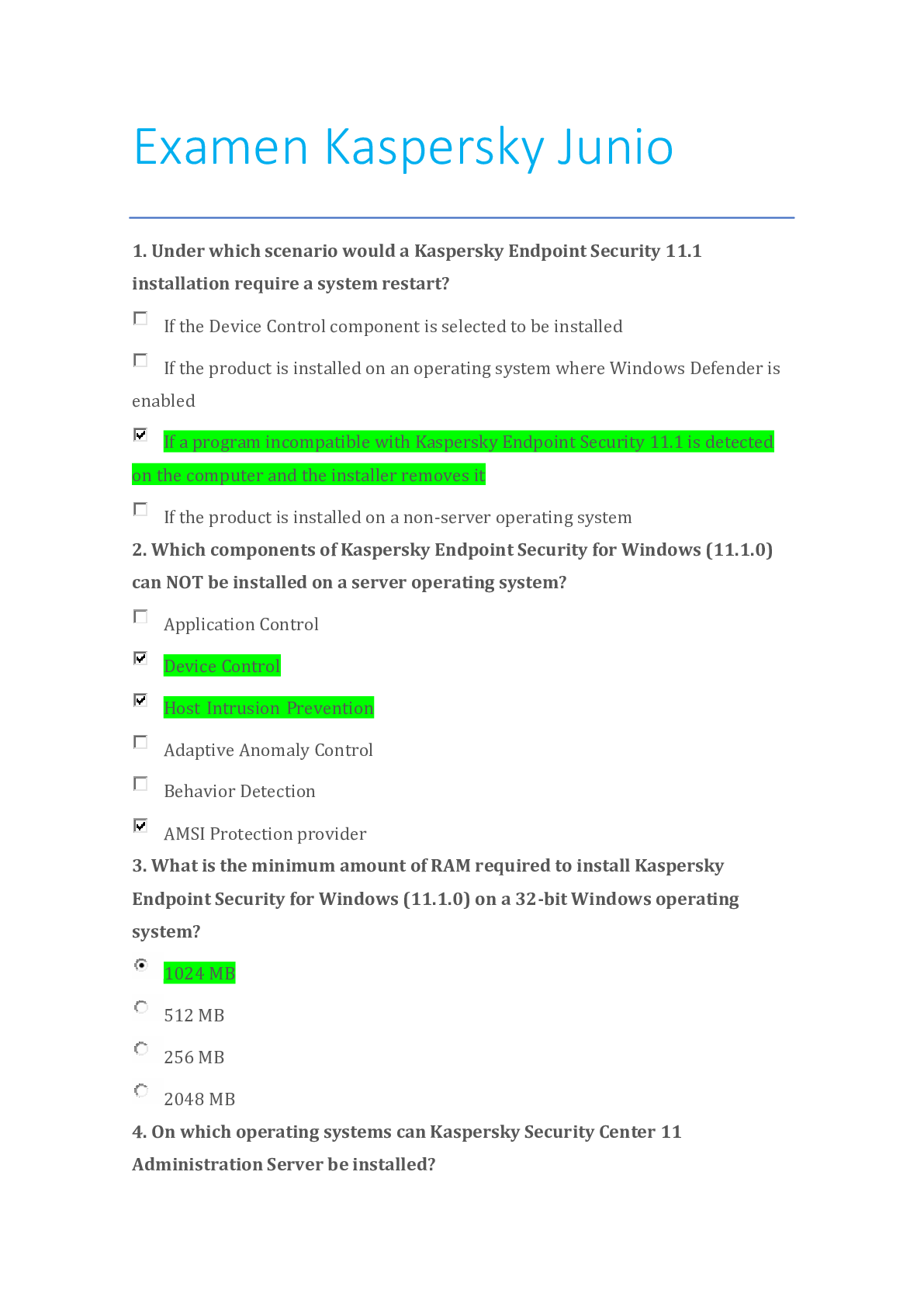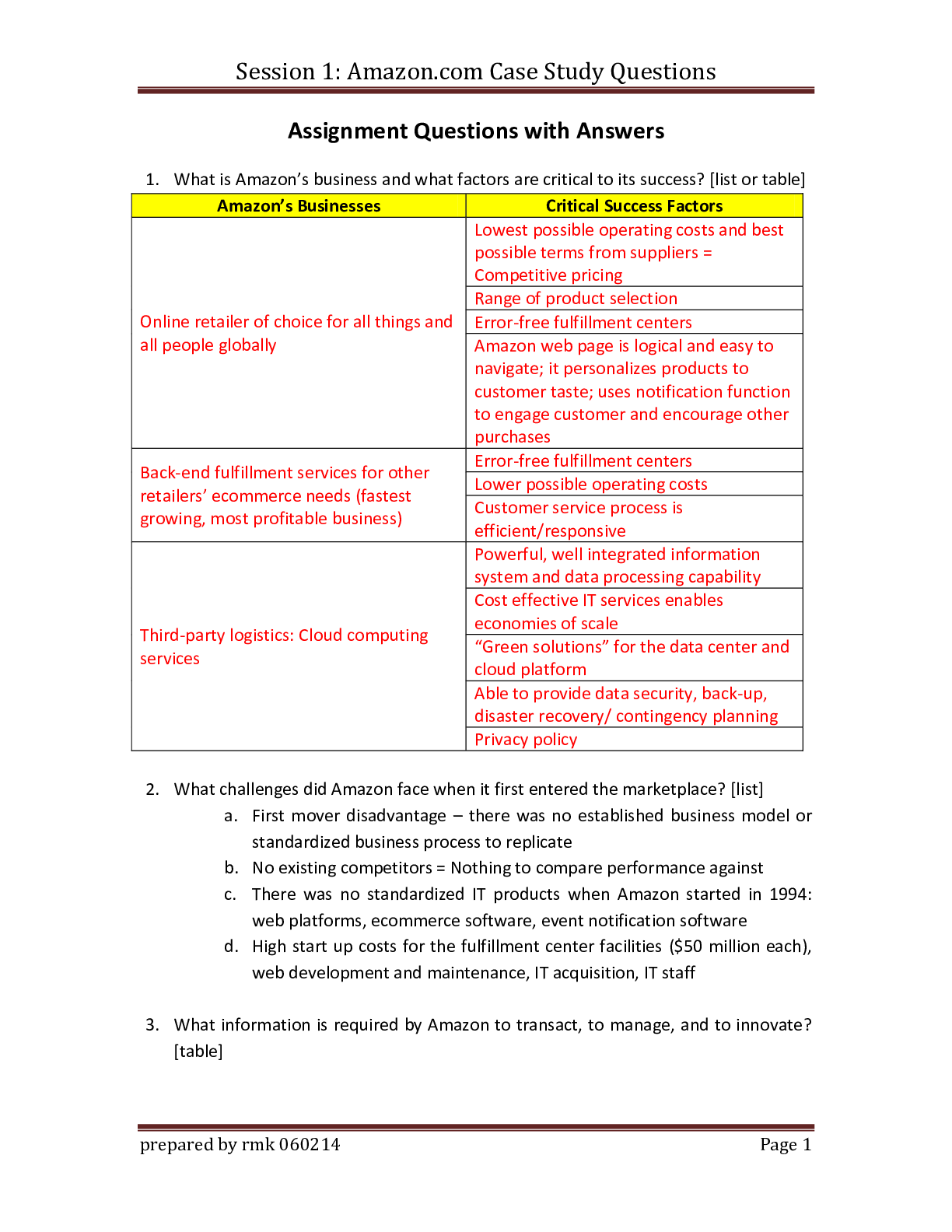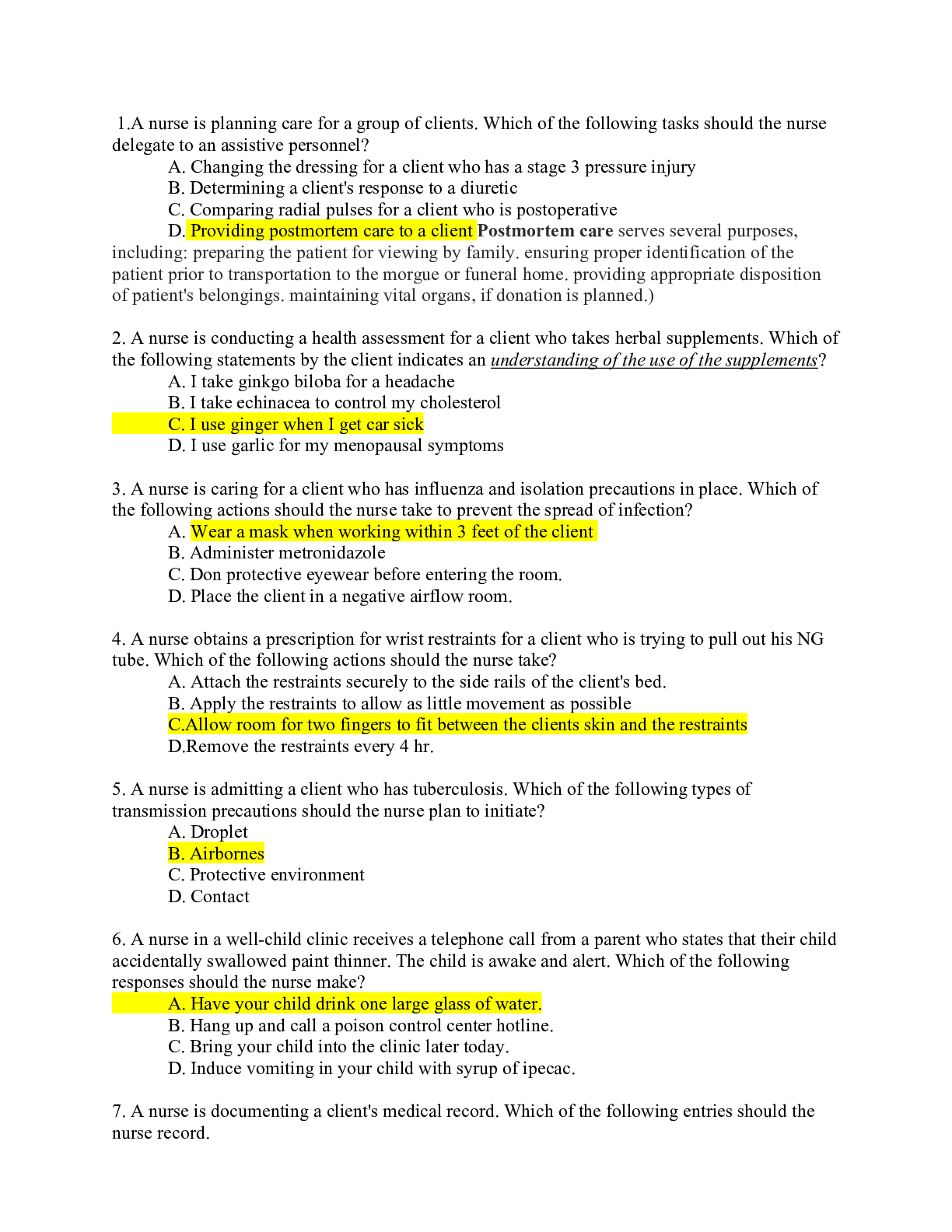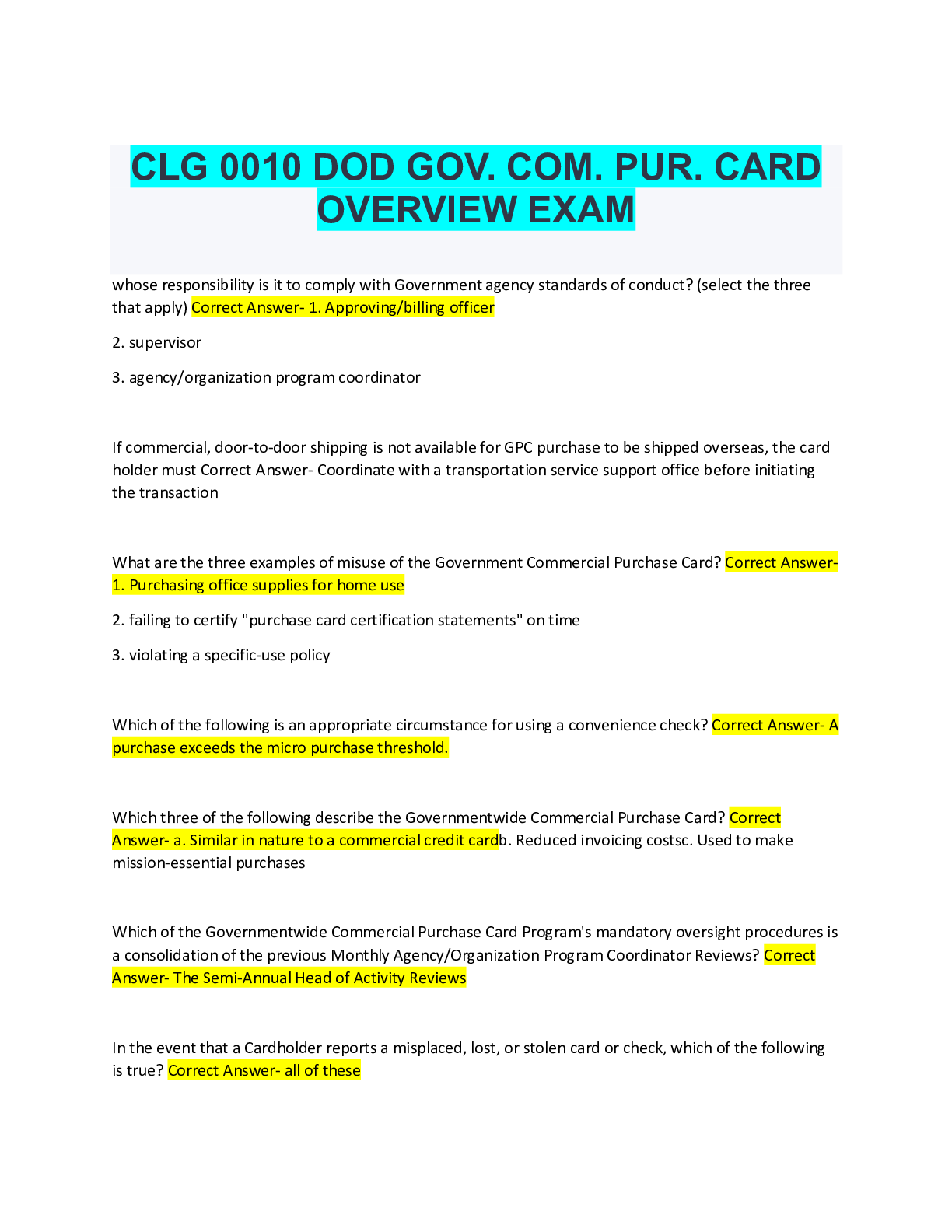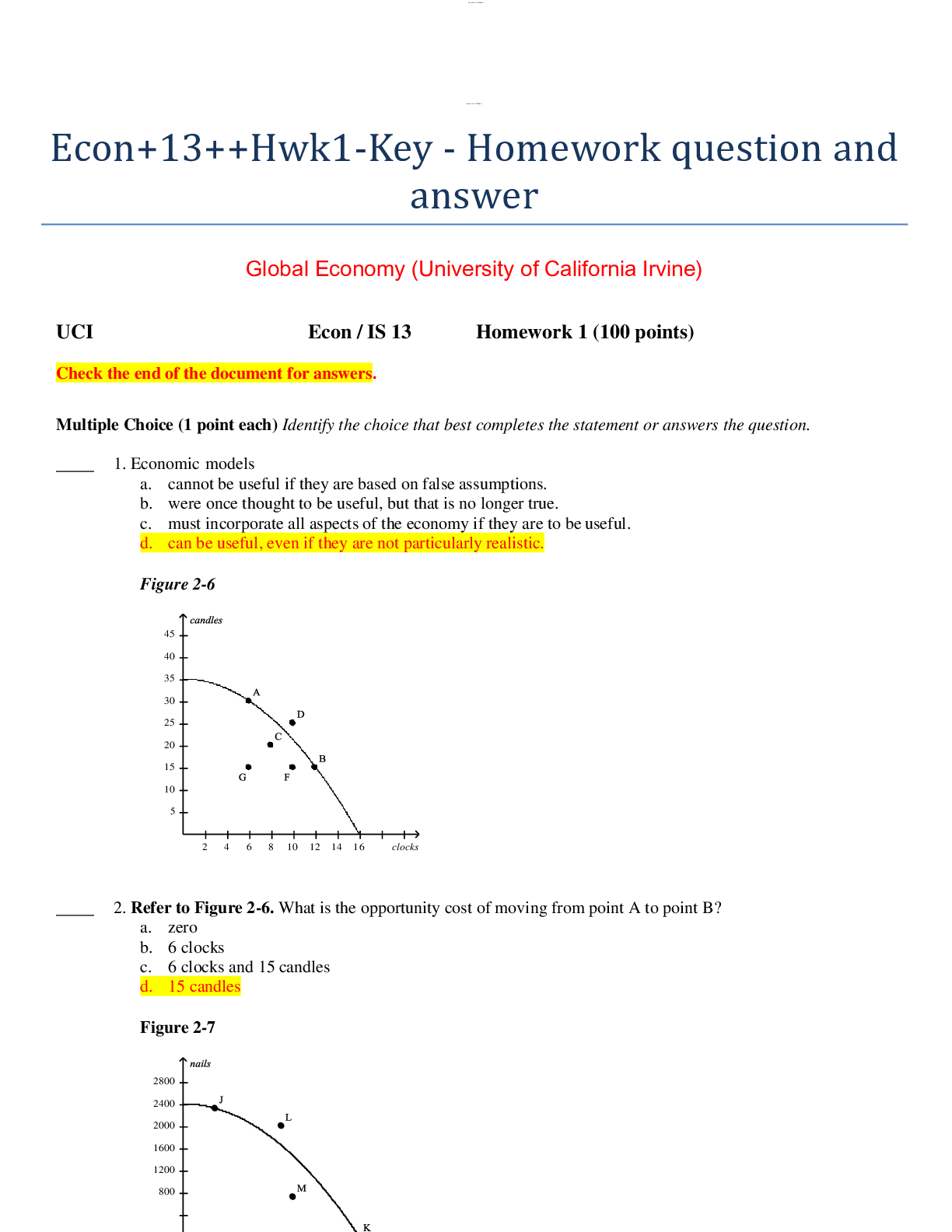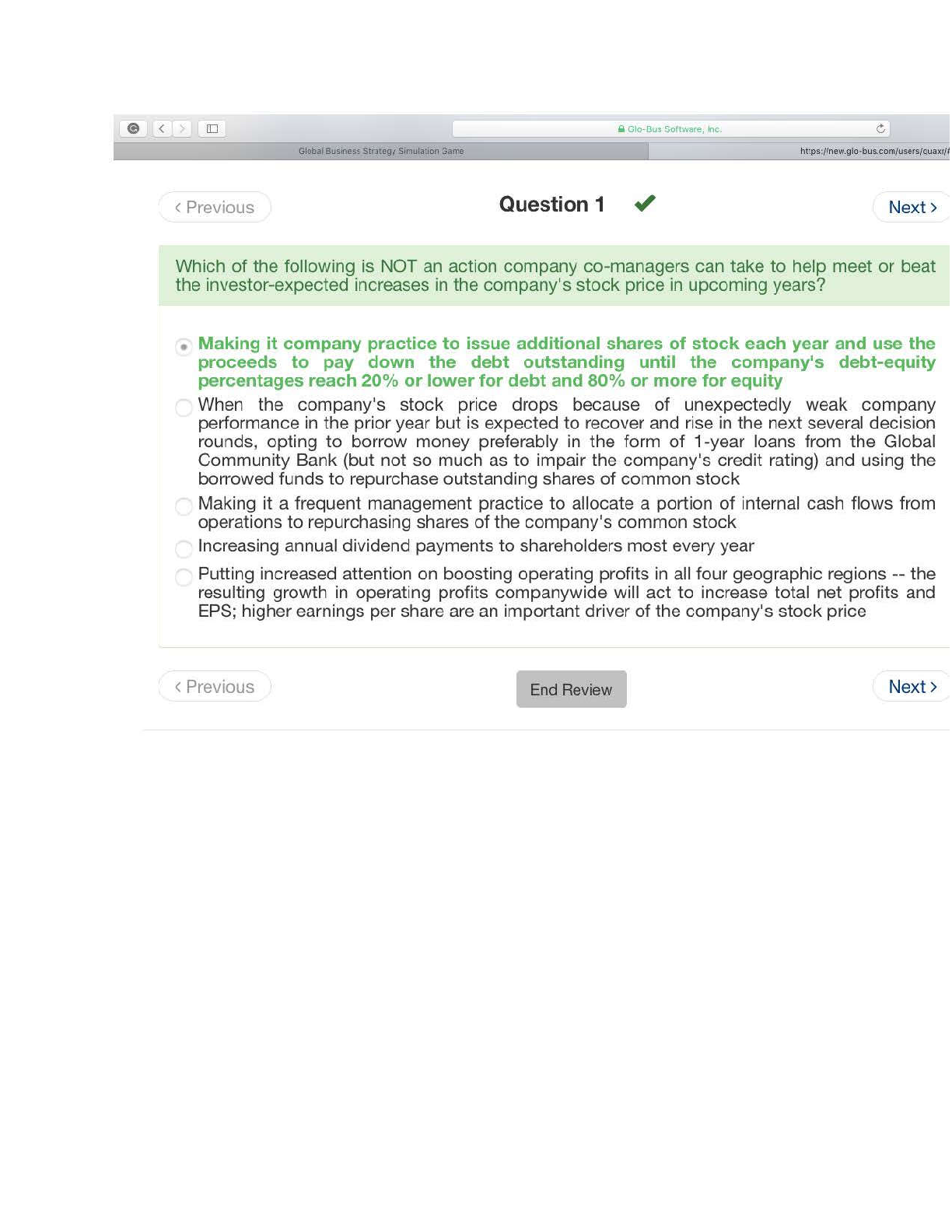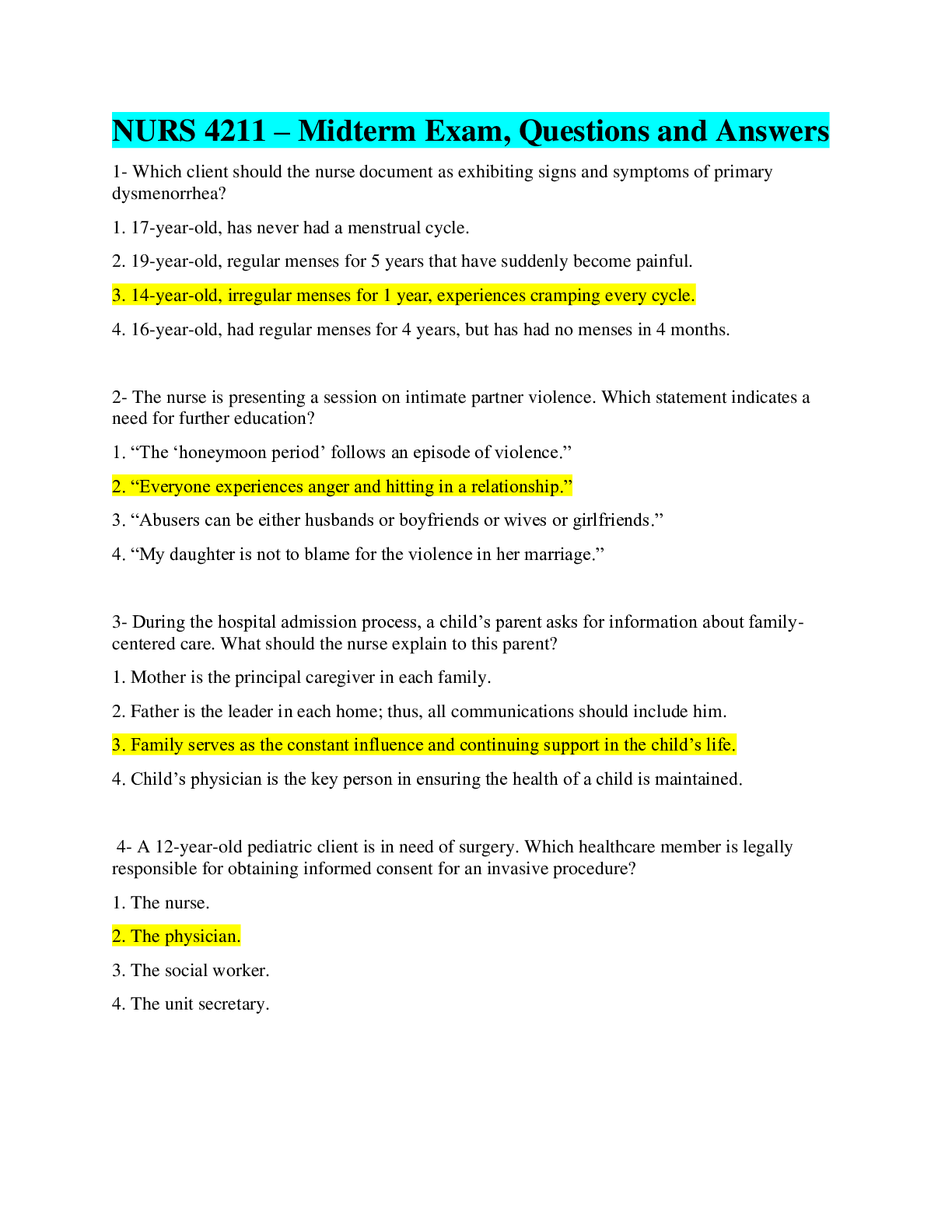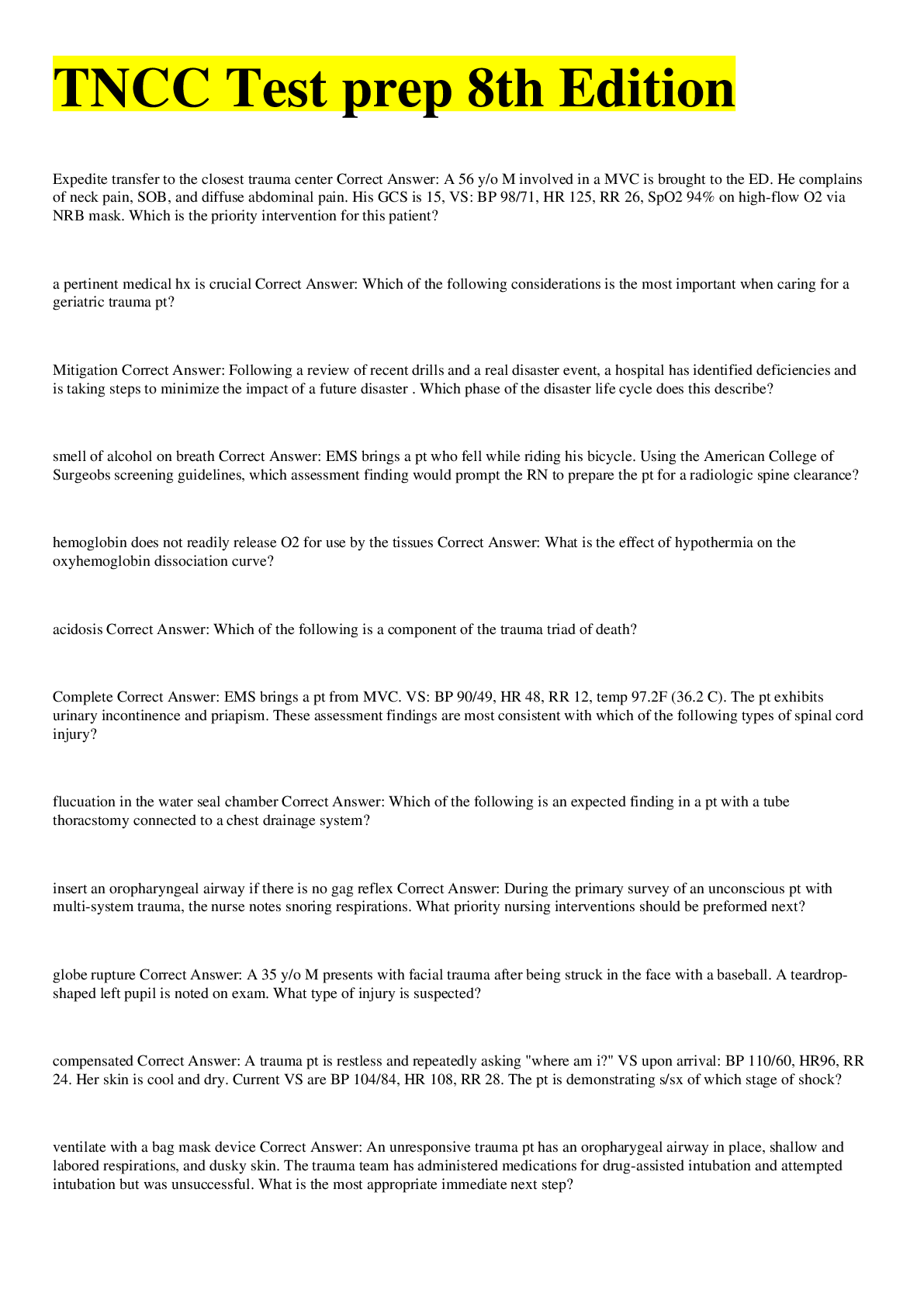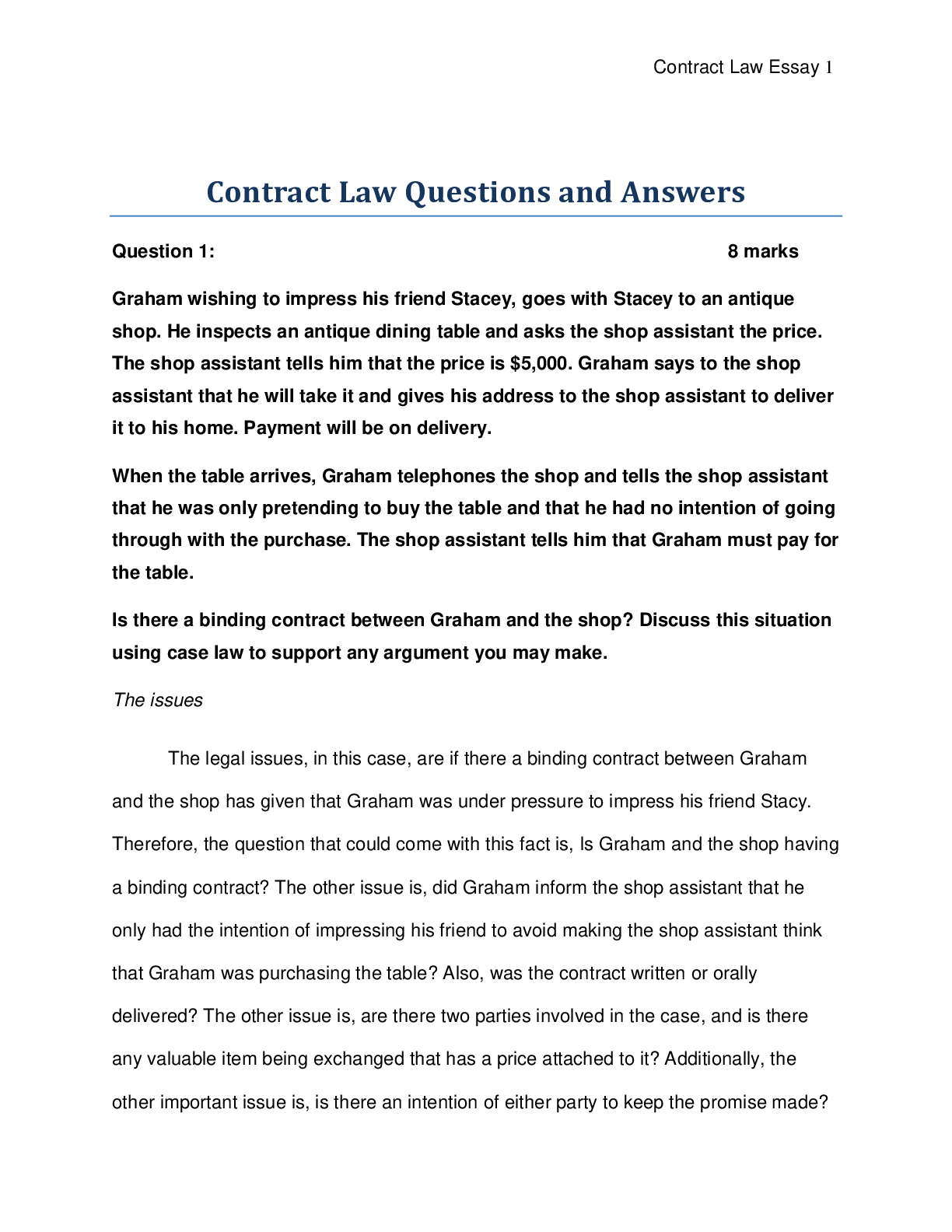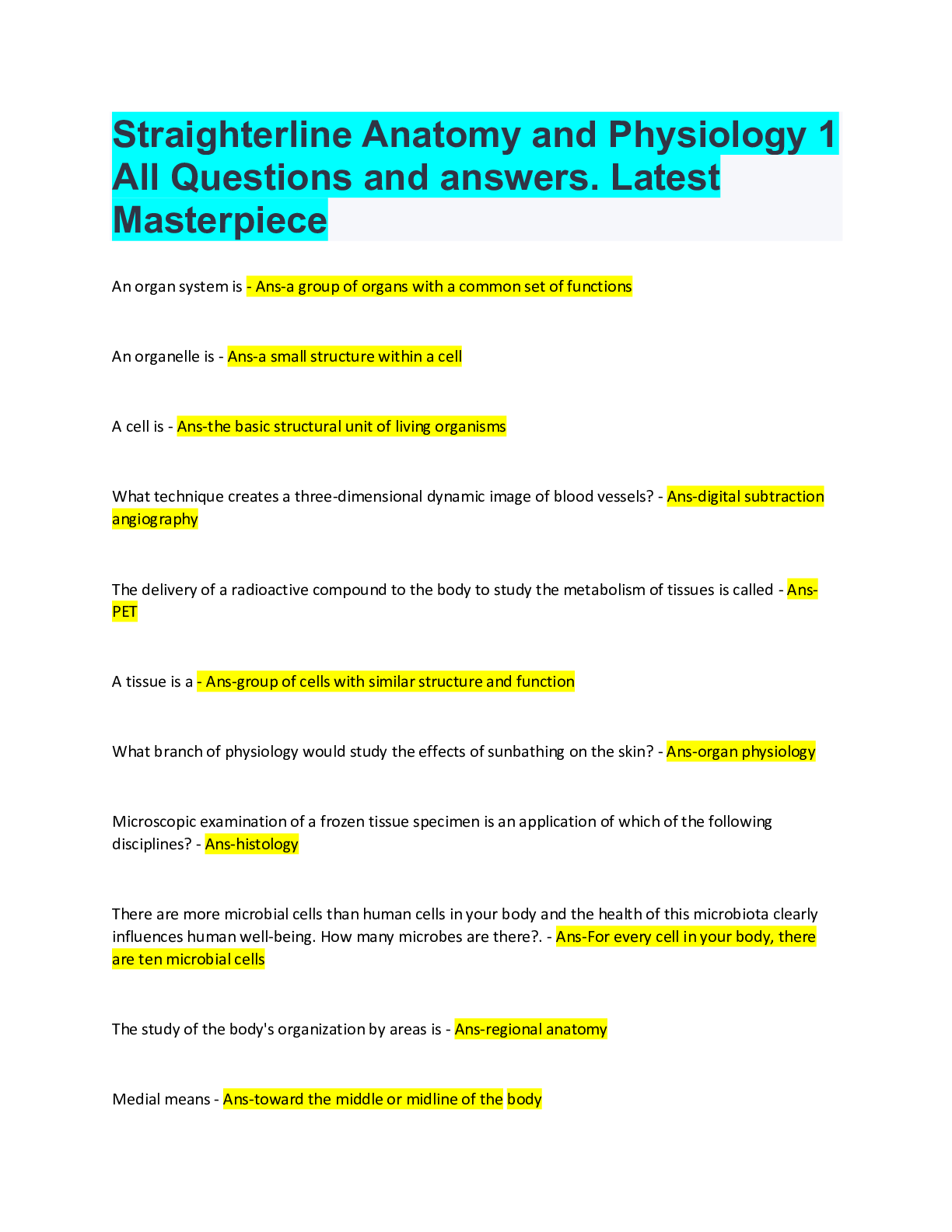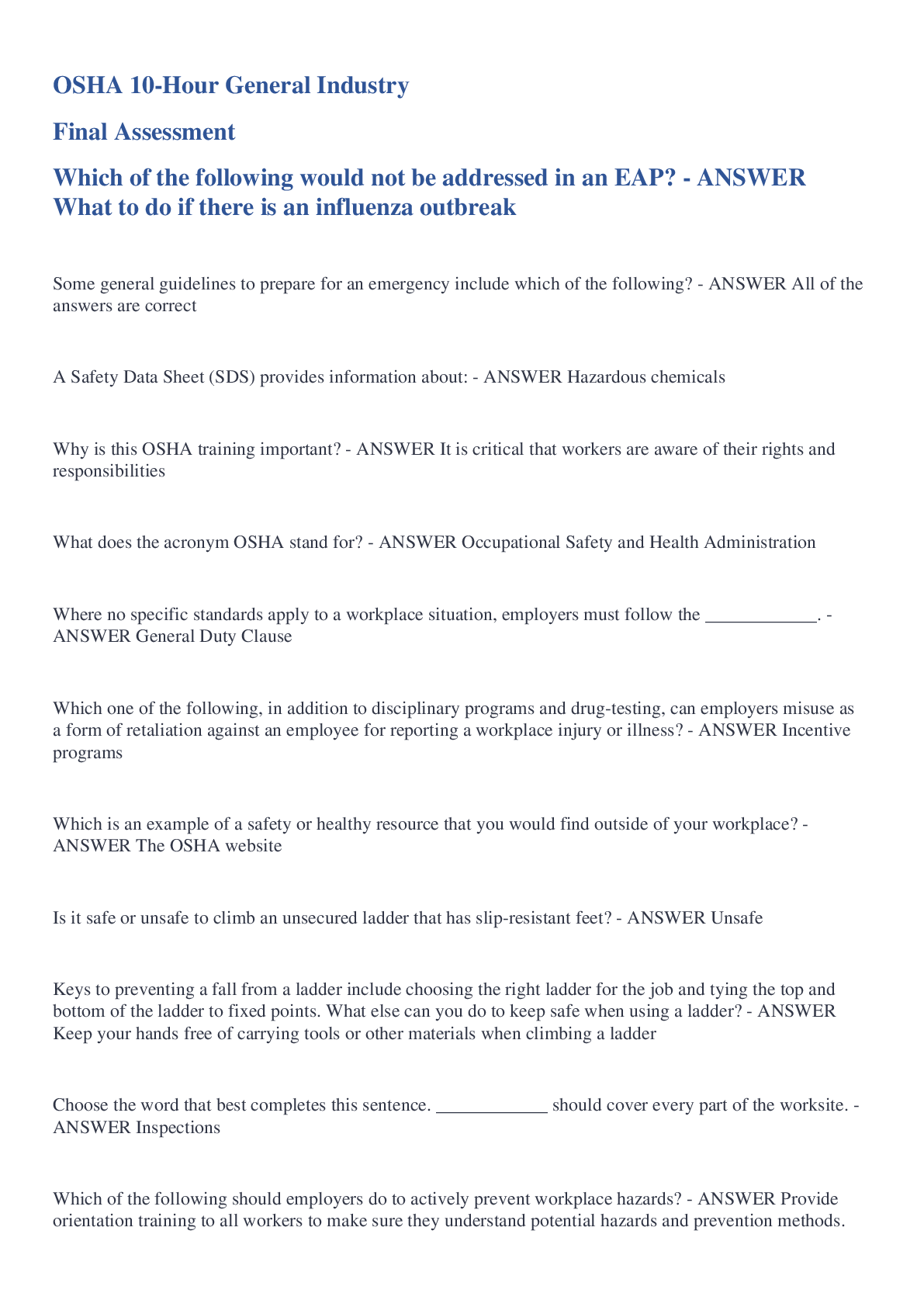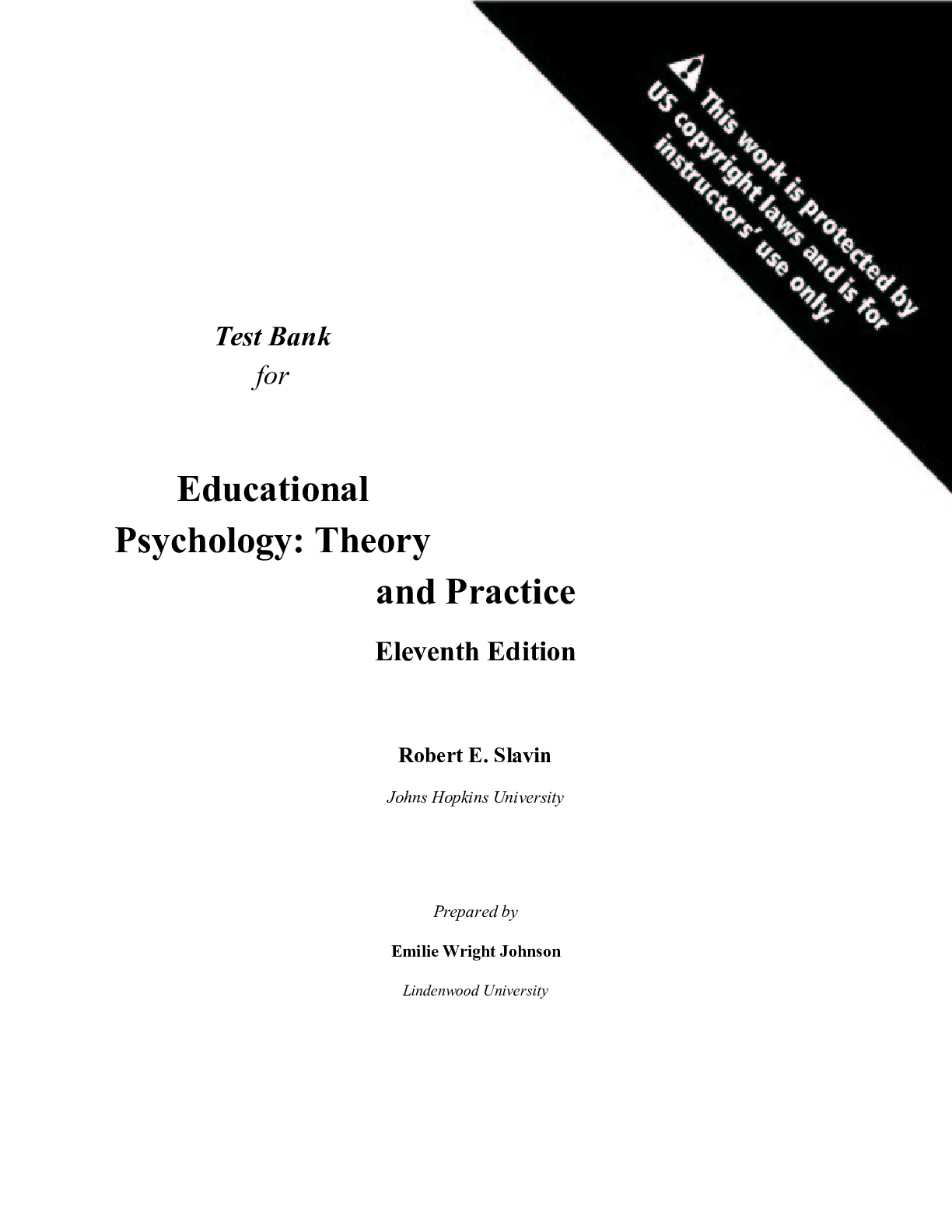Pharmacology > QUESTIONS & ANSWERS > Southern University and A&M College - PHARM 220: Pharmacology Exam 3 Questions and Answers. 100% Cor (All)
Southern University and A&M College - PHARM 220: Pharmacology Exam 3 Questions and Answers. 100% Correct.
Document Content and Description Below
1. The number of people with hypertension in the United States is estimated to be a. 10 million. b. 25 million. c. 50 million. d. 70 million. 2. When administering an alpha-adrenergic drug for hy... pertension, it is most important for the nurse to assess the patient for the development of what response? a. Hypotension b. Hyperkalemia c. Oliguria d. Respiratory distress 3. A patient with diabetes has a new prescription for the ACE inhibitor lisinopril. She questions this order because her physician has never told her that she has hypertension. What is the best explanation for this order? a. The doctor knows best. b. The patient is confused. c. This medication has cardioprotective properties. d. This medication has a protective effect on the kidneys for patients with diabetes. 4. A patient with a history of pancreatitis and cirrhosis is also being treated for hypertension. Which drug will most likely be ordered for this patient? a. Clonidine b. Prazosin c. Diltiazem d. Captopril 5. Which statement about ARBs does the nurse identify as being true? a. Hyperkalemia is more likely to occur than when using ACE inhibitors. b. Cough is more likely to occur than when using ACE inhibitors. c. Chest pain is a common adverse effect. d. Overdose is usually manifested by hypertension and bradycardia. 6. A patient is mowing his lawn on a hot Saturday afternoon. He begins to notice chest pain. What should his first action be? a. Take his nitroglycerin tablet. b. Stop mowing and sit or lie down. c. Go inside the house to cool off and get a drink of water. d. Call 911.7. A patient with extremely high blood pressure (BP) is in the emergency department. The physician will order therapy with nitroglycerin to manage the patient’s BP. Which form of nitroglycerin is most appropriate? a. Sublingual spray b. Transdermal patch c. Oral capsule d. IV infusion 8. The nurse is obtaining a medication history on a patient presenting with chest pain. What drug classification would necessitate the nurse informing the provider before beginning the prescribed nitroglycerin? a. Proton pump inhibitor b. Phosphodiesterase inhibitors (Erectile Dysfunction medications) c. Inhaled beta blocker d. Acetylsalicylic acid (aspirin) 9. A patient with a known history of angina was walking his dog and developed chest pain. The patient immediately stops walking and sits down. He continues to experience chest pain when sitting down. When should he call 911? a. Immediately b. If the pain becomes more severe c. If one sublingual tablet does not relieve the pain after 5 minutes d. If the pain is not relieved after three sublingual tablets, taken 5 minutes apart 10. A patient who has had an MI is taking a beta blocker. What is the main benefit of beta blocker therapy for this patient? a. Vasodilation of the coronary arteries b. Increased force of cardiac contraction c. Slowing of the heart rate d. Maintaining adequate BP 11. The nurse is preparing to educate a group of patients on the management of angina. a. Which drug groups are most often used to treat patients with angina? 12. A patient asks the nurse to tell her more about a new drug the patient has been prescribed called ranolazine (Ranexa). Which response by the nurse is accurate? a. “We do not know how Ranexa works.” b. “This drug is the first medication your health care provider will use to treat your angina.” c. “This drug must be given intravenously.” d. “Ranexa is safe to use in patients with liver failure.”13. What information will the nurse include when teaching the patients about taking beta2-blocking drugs for the treatment of angina? a. “Call your health care provider if you heart rate is 64 beats/min.” b. “These drugs are safe to use in patients who have asthma.” c. “Call your health care provider if you experience a weight gain of 2 lb or more in 24 hours or 5 lb or more in 1 week.” d. “Avoid taking these medications with grapefruit juice.” 14. A patient asks how to apply transdermal nitroglycerin. What is the nurse’s best response? a. “Always apply the transdermal patch over the area of your chest where your heart is.” b. “Keep the previous patch on for 1 full day so you always have two patches on at a time.” c. “Apply the patch to hairless areas of the body.” d. “First apply Vaseline to your body; then apply the transdermal patch.” 15. Which patient is the best candidate to receive nesiritide therapy? a. A patient with atrial fibrillation who has not responded to other drugs b. A patient needing initial treatment for HF c. A patient with reduced cardiac output d. A patient with acutely decompensated HF who has dyspnea at rest 16. A patient is in the emergency department with new-onset atrial fibrillation. Which order for digoxin would most likely have the fastest therapeutic effect? a. Digoxin 0.25 mg PO daily b. Digoxin 1 mg PO now; then 0.25 mg PO daily c. Digoxin 0.5 mg IV push daily d. Digoxin 1 mg IV push now; then 0.25 mg IV daily 17. A patient is receiving digoxin 0.25 mg/day as part of treatment for HF. The nurse assesses the patient before medication administration. Which assessment finding would be of most concern? a. Apical heart rate of 58 beats/min b. Ankle edema +1 bilaterally c. Serum potassium level of 2.9 mEq/L d. Serum digoxin level of 0.8 ng/mL 18. A patient with a history of HF presents to the emergency department with difficulty breathing, cough, and edema of the lower extremities. The nurse anticipates administration of which type of medication? a. Positive chronotrope b. Negative chronotrope c. Positive inotrope d. Negative inotrope19. The patient is prescribed an ACE inhibitor. What primary mechanism of ACE inhibitors will the nurse understand as the therapeutic action? a. To inhibit catecholamine release b. To inhibit acetylcholine release c. To inhibit aldosterone secretion d. To prevent vagal stimulation 20. The patient is discharged home and returns to the emergency department 4 days later. The patient is admitted to the ICU with acute decompensated HF with dyspnea at rest. The nurse anticipates administration of which medication? a. Atropine b. Carvedilol (Coreg) c. Lisinopril (Prinivil) d. Nesiritide (Natrecor) 21. A patient has received an IV dose of adenosine, and almost immediately the heart monitor shows asystole. What should the nurse do next? a. Check the patient’s pulse. b. Prepare to administer cardiopulmonary resuscitation. c. Set up for defibrillation. d. Continue to monitor the patient. 22. A patient is in the emergency department with an unspecified supraventricular dysrhythmia. The physician orders a dose of diltiazem (Cardizem) IV push. While the nurse administers the medication through the IV lock, the patient says she feels something wet spilling on her arm. Her heart rate was unchanged. What will the nurse do next? a. Assess the patient for diaphoresis. b. Check the IV lock to see if it is functioning properly. c. Repeat the dose of diltiazem (Cardizem). d. Restart the IV in another location. 23. A patient is receiving oral quinidine. Which assessment finding is of most concern? a. Nausea b. Prolonged QT interval c. Diarrhea d. Occasional palpitations [Show More]
Last updated: 1 year ago
Preview 1 out of 57 pages
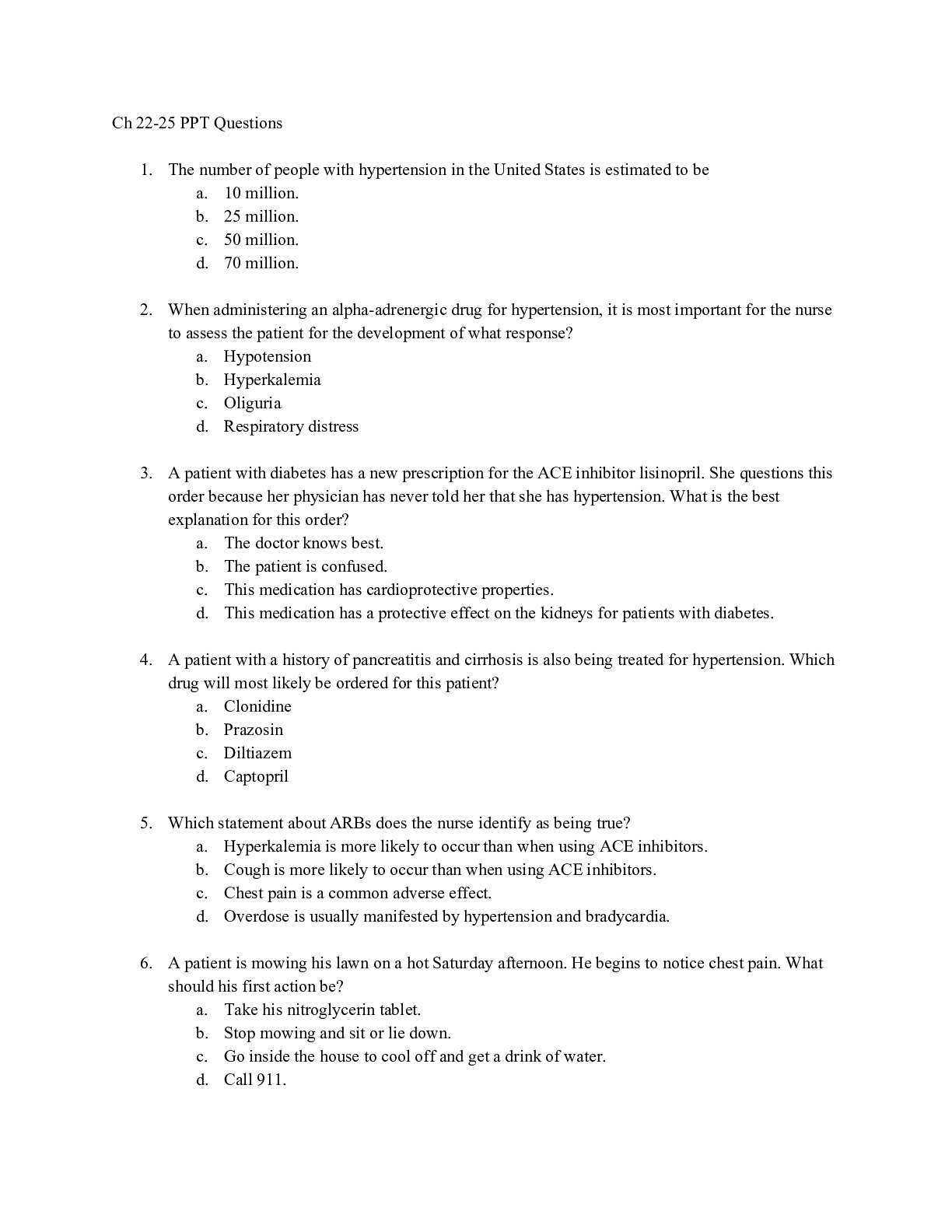
Reviews( 0 )
Document information
Connected school, study & course
About the document
Uploaded On
Jun 30, 2020
Number of pages
57
Written in
Additional information
This document has been written for:
Uploaded
Jun 30, 2020
Downloads
0
Views
46





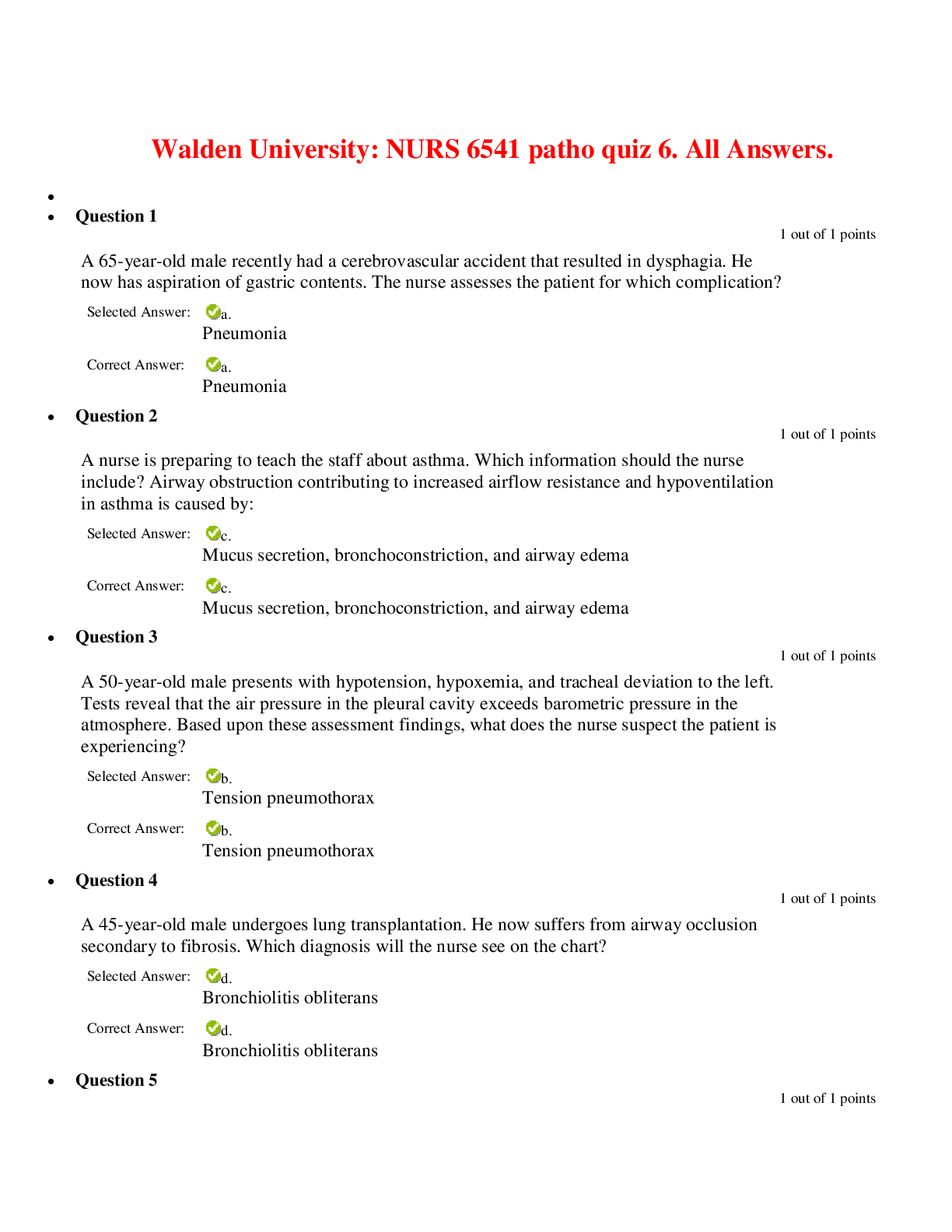





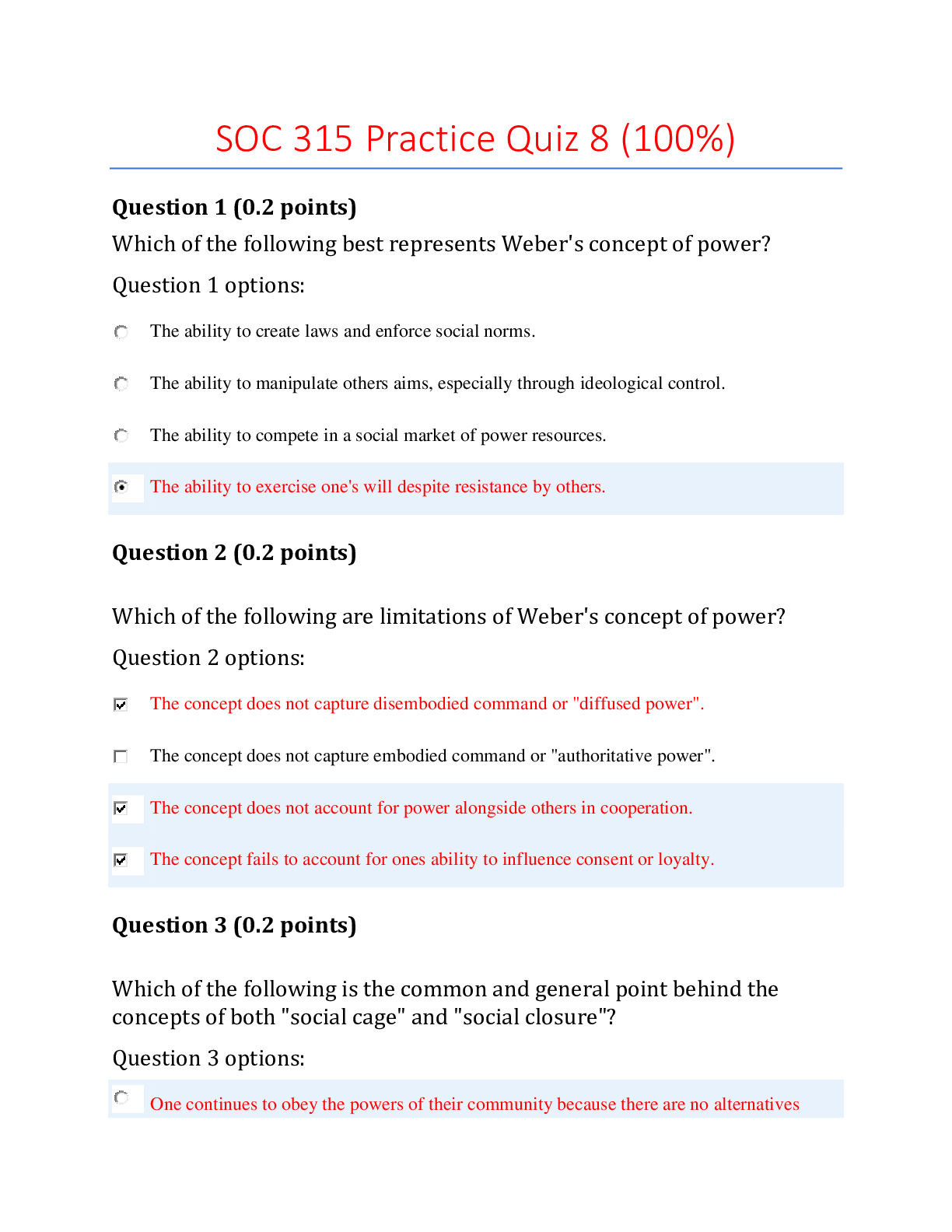
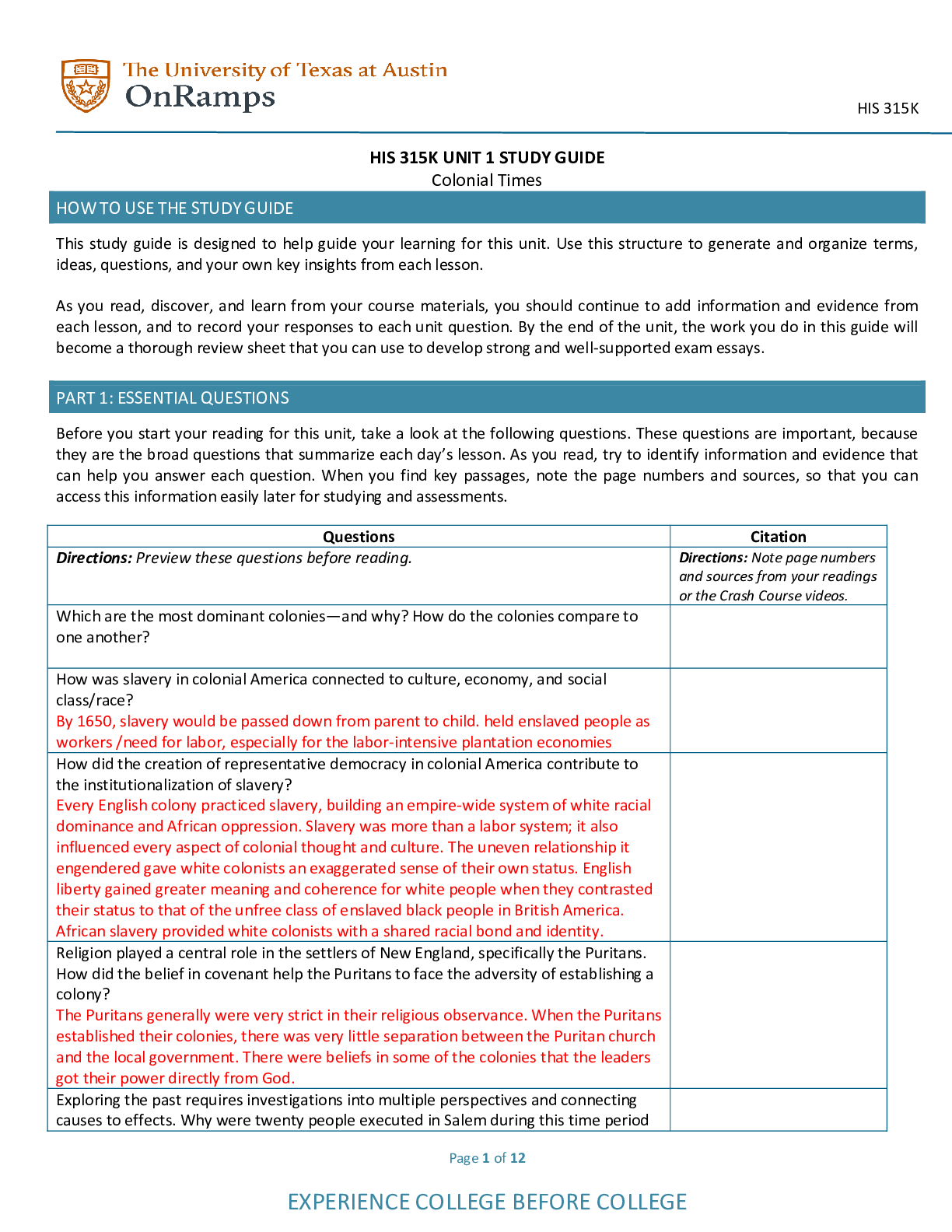
.png)

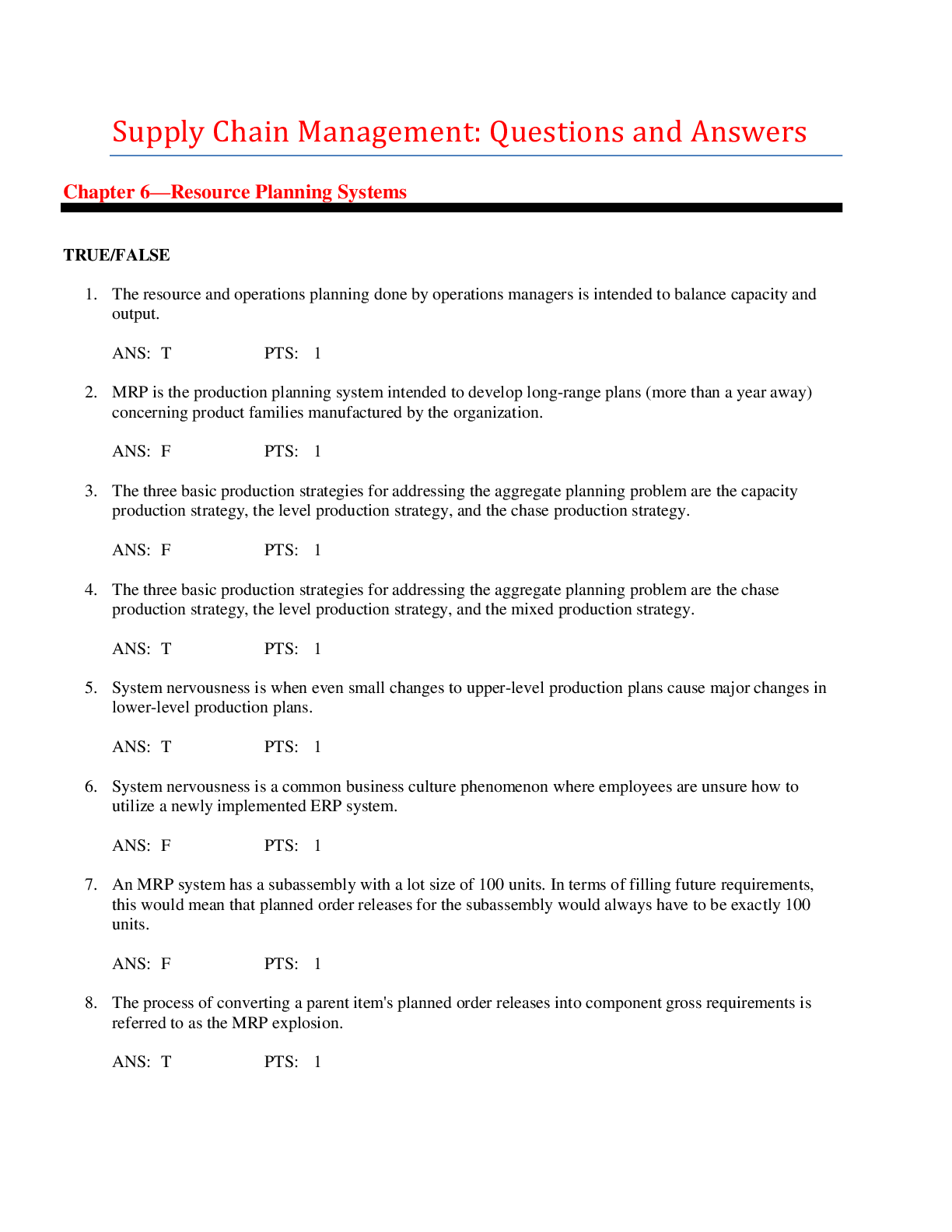
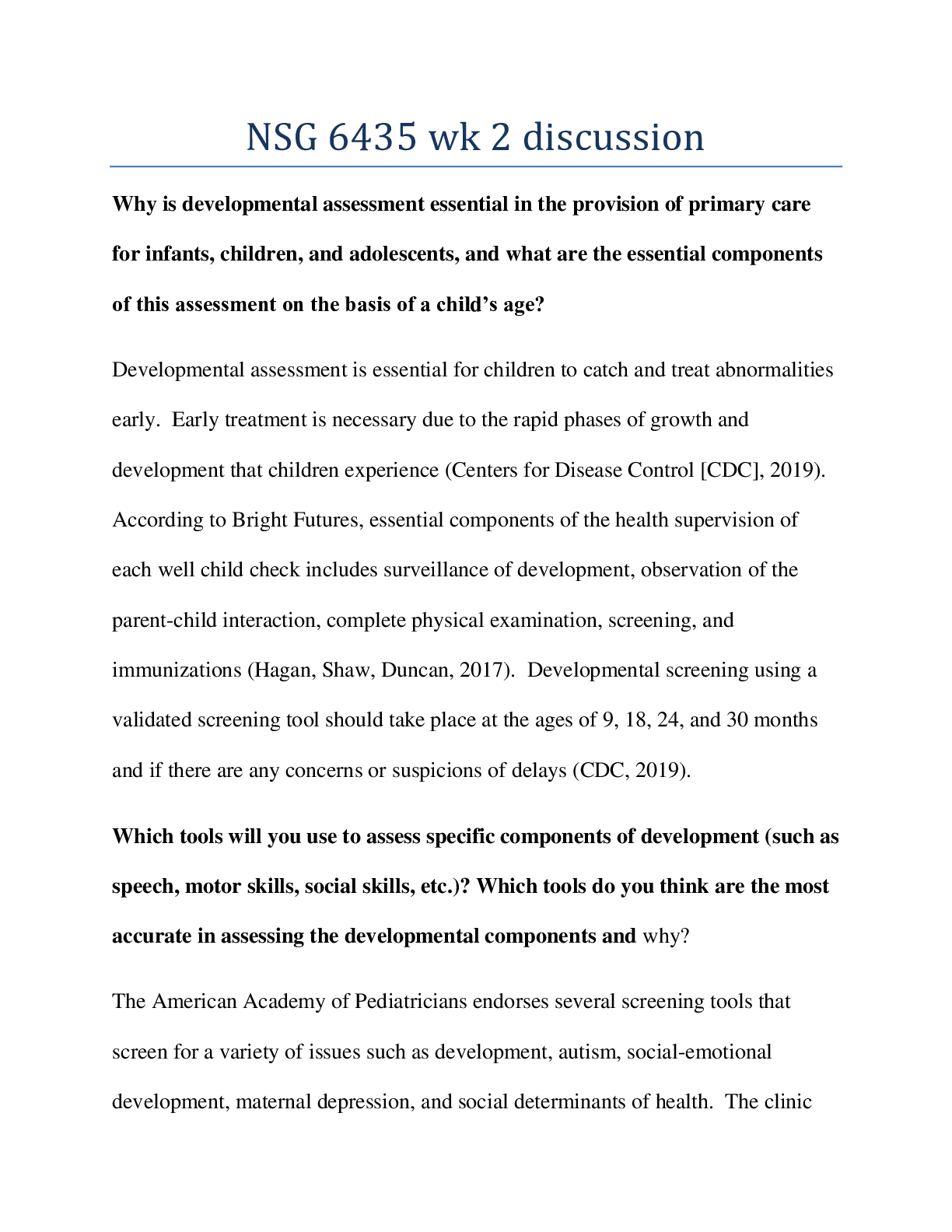

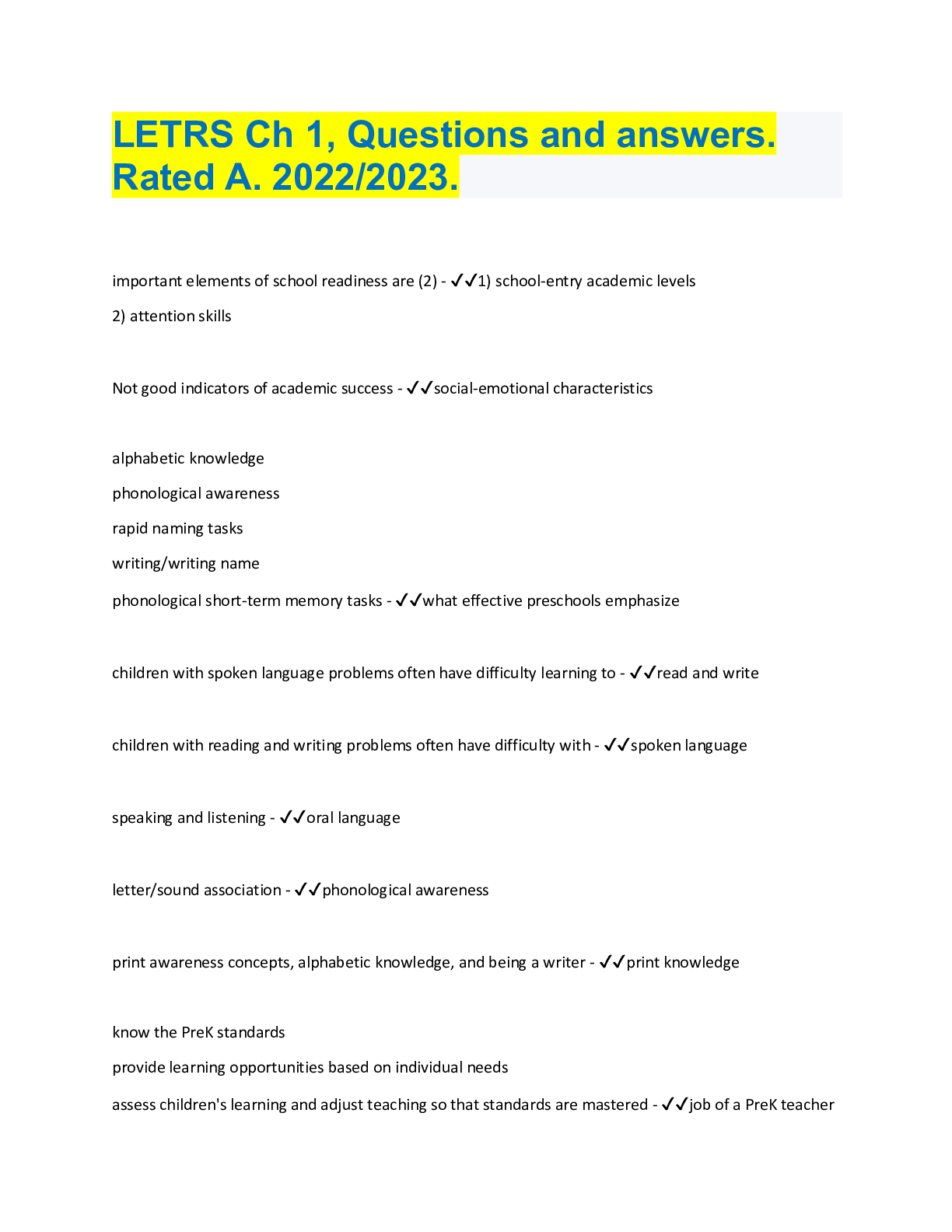
.png)

.png)

